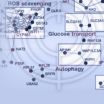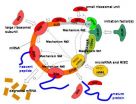(Press-News.org) TORONTO, July 31, 2012 – Think you know what one serving of food looks like? You may want to think again, according to a new study from York University.
Many people overestimate the size of one serving of food as defined in Canada's Food Guide, so they may be overeating even if they believe they are being careful, according to a study by Jennifer Kuk, a professor in the School of Kinesiology & Health Science in York's Faculty of Health, and lead author Sharona Abramovitch, a former graduate student at York. The study was published online today in the journal Applied Physiology, Nutrition and Metabolism.
Canada's Food Guide is an important tool used by many general practitioners to help their patients eat more healthfully, says Kuk, so it made sense to study whether people would be able to tell from the food guide if they are eating enough of the four food groups: vegetables and fruit, meat and alternatives, grain products, and milk and alternatives.
"What we found was that the way people estimate one serving is essentially how much they would normally eat at one time," says Kuk. "The majority of participants in the study inaccurately thought they would need to increase their food consumption by approximately 400 calories to meet recommendations in Canada's Food Guide. This suggests we either need to change the size of a serving in the Guide – which has remained almost the same since 1977 – or educate Canadians more about how much food they should be consuming in a day."
That 8-ounce steak you throw on the barbeque this summer, for example, alone exceeds the Canada Food Guide's maximum daily allowance for meat and alternatives, says Abramovitch, a former graduate student in the School of Kinesiology & Health Science in York's Faculty of Health. And only half a cup of cooked pasta is one of the eight grain servings allowed per day for a male between the ages of 19 and 50.
Researchers analyzed food records from the 145 participants in the study, which included White, Black, South Asian and East Asian adults. They were asked to select what they thought was a serving, and researchers measured it to see whether the serving size corresponded with Canada's Food Guide. They were also asked to estimate how much of something – for example, pasta – they would eat at one sitting, and to recall their diet over 24 hours.
All four ethnic groups inaccurately estimated the total number of servings they were eating in a day: they underestimated the number of servings of fruit and vegetables, grain products and meat and overestimated the number of servings of milk and alternatives they were eating.
###The research was funded by the Heart and Stroke Foundation.
Watch the VIDEO.
York University is a leading interdisciplinary research and teaching university in Canada. York offers a modern, academic experience at the undergraduate and graduate level in Toronto – Canada's most international city. The third largest university in the country, York is host to a dynamic academic community of 55,000 students and 7,000 faculty and staff, as well as 250,000 alumni worldwide. York's 10 faculties and 28 research centres conduct ambitious, groundbreaking research that is interdisciplinary, cutting across traditional academic boundaries. This distinctive and collaborative approach is preparing students for the future and bringing fresh insights and solutions to real-world challenges. York University is an autonomous, not-for-profit corporation.
Media Contact:
Janice Walls, Media Relations, York University, 416 736 2100 x22101 / wallsj@yorku.ca
Canadians super-sizing Canada's Food Guide servings: York University study
2012-07-31
ELSE PRESS RELEASES FROM THIS DATE:
Protein-based coating could help rehabilitate long-term brain function
2012-07-31
Brain-computer interfaces are at the cutting edge for treatment of neurological and psychological disorder, including Parkinson's, epilepsy, and depression. Among the most promising advance is deep brain stimulation (DBS) — a method in which a silicon chip implanted under the skin ejects high frequency currents that are transferred to the brain through implanted electrodes that transmit and receive the signals. These technologies require a seamless interaction between the brain and the hardware.
But there's a catch. Identified as foreign bodies by the immune system, the ...
Can herbal products provide sun protection?
2012-07-31
New Rochelle, NY, July 31, 2012—Recent research supports the ability of some herbal agents, taken orally or applied topically, to prevent sunburn and limit the damage caused by excessive exposure to ultraviolet (UV) light. Natural products with proven and promising photoprotective properties are highlighted in an article in Alternative and Complementary Therapies, published by Mary Ann Liebert, Inc., publishers. The article is available free on the Alternative and Complementary Therapies website at http://www.liebertpub.com/act.
The article "Herbal Sunscreens and Ultraviolet ...
Computational analysis identifies drugs to treat drug-resistant breast cancer
2012-07-31
HEIDELBERG, 31 July 2012 – Researchers have used computational analysis to identify a new Achilles heel for the treatment of drug-resistant breast cancer. The results, which are published in Molecular Systems Biology, reveal that the disruption of glucose metabolism is an effective therapeutic strategy for the treatment of tumours that have acquired resistance to front-line cancer drugs such as Lapatinib.
"The growth and survival of cancer cells can often be impaired by treatment with drugs that interfere with the actions of one or more oncogenes," said Prahlad Ram, the ...
Economic recession leads to increased entrepreneurship, MU study finds
2012-07-31
COLUMBIA, Mo. — The recent economic recession has caused many changes in the business landscape across the country, including high unemployment rates. Due to these high rates and the struggling economy, University of Missouri researchers have found that in recent years the number of Americans engaging in entrepreneurship has risen significantly. Maria Figueroa-Armijos, a doctoral candidate in the University of Missouri Truman School of Public Affairs, says that this trend could be positive for the future.
"We've seen similar trends occur in past economically slow periods ...
Chemistry on Mars video with Curiosity Rover from the American Chemical Society
2012-07-31
WASHINGTON, July 31, 2012 - After an epic 354-million-mile trek through space, the Mars Curiosity Rover is zooming along at 13,000 miles per hour toward a scheduled August 6 landing on the Red Planet to search for evidence of extraterrestrial life. The newest episode of the American Chemical Society's (ACS') award-winning Bytesize Science video series highlights Curiosity Rover's mission, scientific instrumentation and the role that chemistry plays in the search for life on other planets. The video, produced by the ACS Office of Public Affairs, is available at www.BytesizeScience.com. ...
Adding a '3D print' button to animation software
2012-07-31
Cambridge, Mass. - July 31, 2012 - Watch out, Barbie: omnivorous beasts are assembling in a 3D printer near you.
A group of graphics experts led by computer scientists at Harvard have created an add-on software tool that translates video game characters -- or any other three-dimensional animations -- into fully articulated action figures, with the help of a 3D printer.
The project is described in detail in the Association for Computing Machinery (ACM) Transactions on Graphics and will be presented at the ACM SIGGRAPH conference on August 7.
Besides its obvious consumer ...
Camouflage of moths: Secrets to invisibility revealed
2012-07-31
Moths are iconic examples of camouflage. Their wing coloration and patterns are shaped by natural selection to match the patterns of natural substrates, such as a tree bark or leaves, on which the moths rest. But, according to recent findings, the match in the appearance was not all in their invisibility.
Despite a long history of research on these iconic insects, whether moths behave in a way to increase their invisibility has not been determined. A research team from the Laboratory of Behavioral Ecology and Evolution at the Seoul National University has conducted an ...
Critically endangered whales sing like birds; New recordings hint at rebound
2012-07-31
When a University of Washington researcher listened to the audio picked up by a recording device that spent a year in the icy waters off the east coast of Greenland, she was stunned at what she heard: whales singing a remarkable variety of songs nearly constantly for five wintertime months.
Kate Stafford, an oceanographer with UW's Applied Physics Lab, set out to find if any endangered bowhead whales passed through the Fram Strait, an inhospitable, ice-covered stretch of sea between Greenland and the northern islands of Norway. Only around 40 sightings of bowhead whales, ...
Mathematicians find solution to biological building block puzzle
2012-07-31
An international team of mathematicians has proposed a new solution to understanding a biological puzzle that has confounded molecular biologists.
They have applied a mathematical model to work out the functioning of small molecules known as microRNAs – components of the body akin to the electronics in modern airplanes.
For a long time molecular biologists thought that the major role of RNA in living cells was to serve as a copy of a gene and a template for producing proteins, major cell building blocks. This belief had been changed at the end of 90s when it was found ...
Low-cost carbon capture gets X-rayed
2012-07-31
Diamond Light Source is being used to improve low cost methods for carbon capture. Scientists from the University of Leeds are using the UK's national synchrotron to investigate the efficiency of calcium oxide (CaO) based materials as carbon dioxide (CO2) sorbents. Their results, published in the journal of Energy & Environmental Science, provide an explanation for one of the key mechanisms involved. This new knowledge will inform efforts to improve the efficiency of this economically viable method of carbon capture and storage.
Current techniques for post-combustion ...




